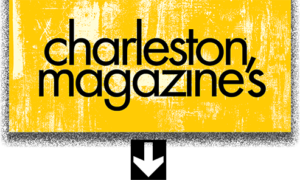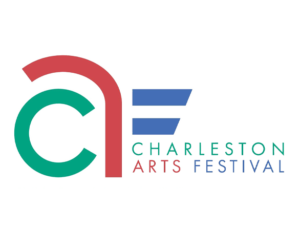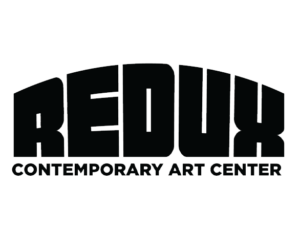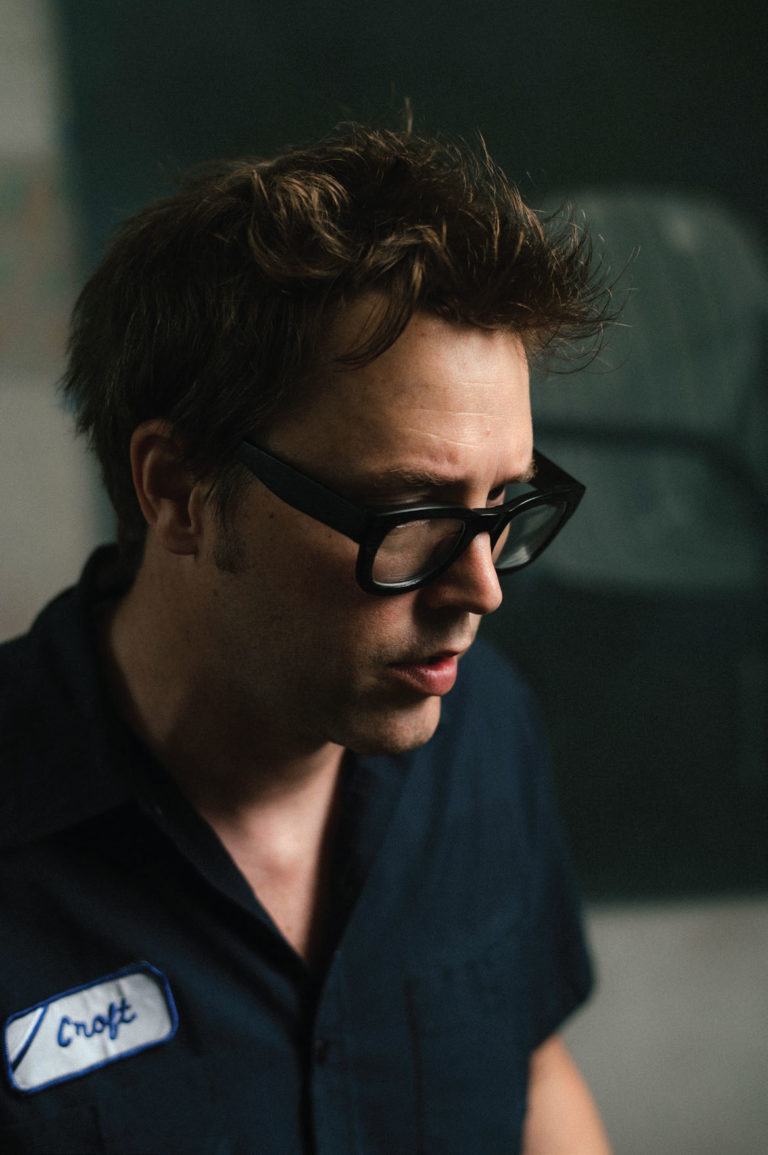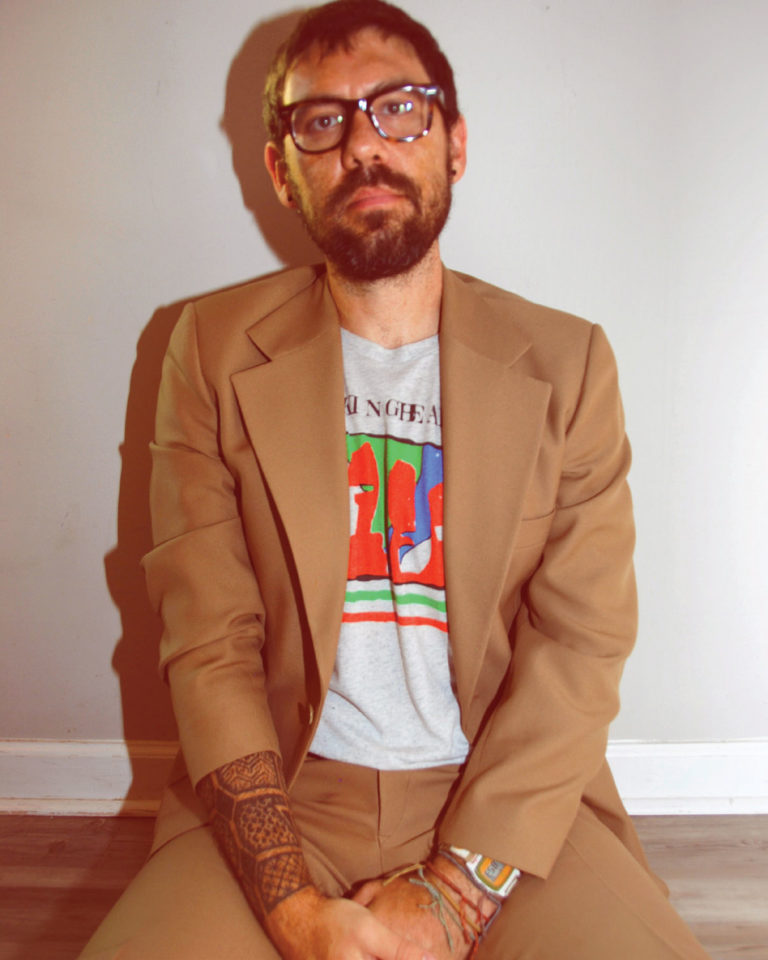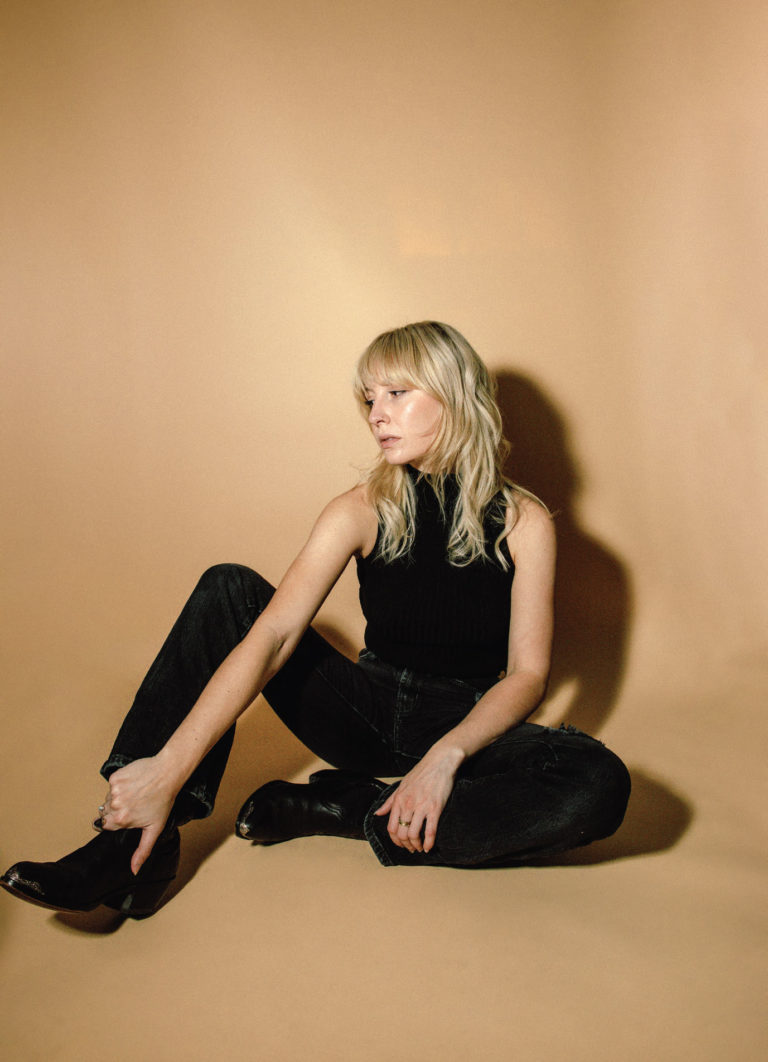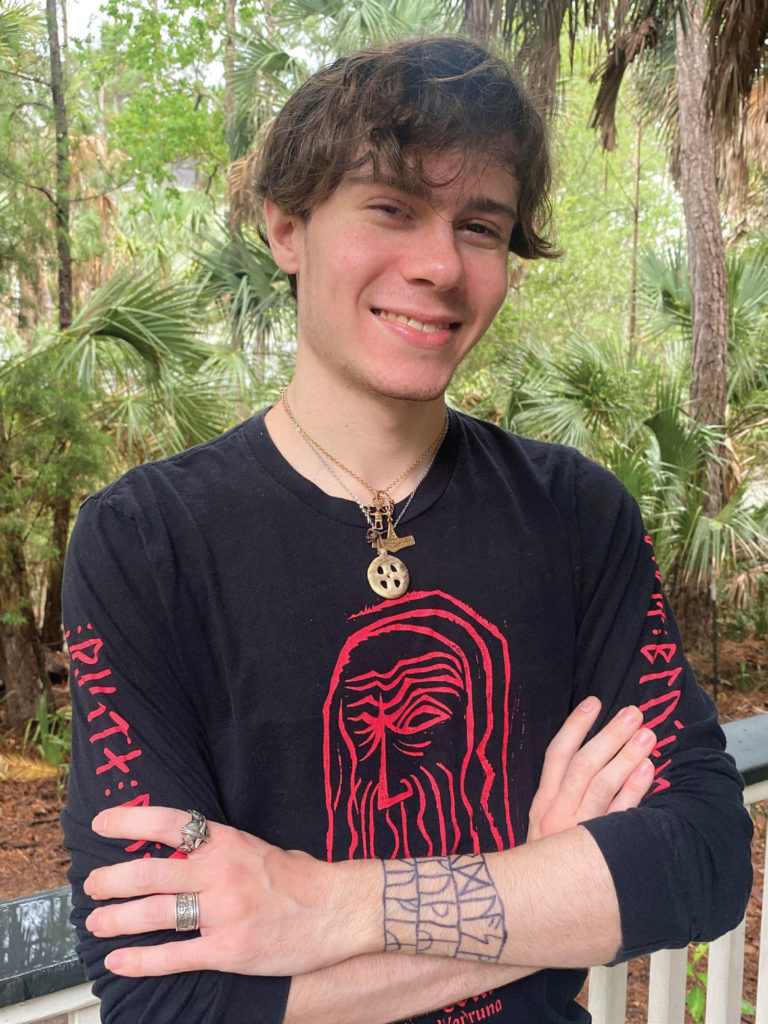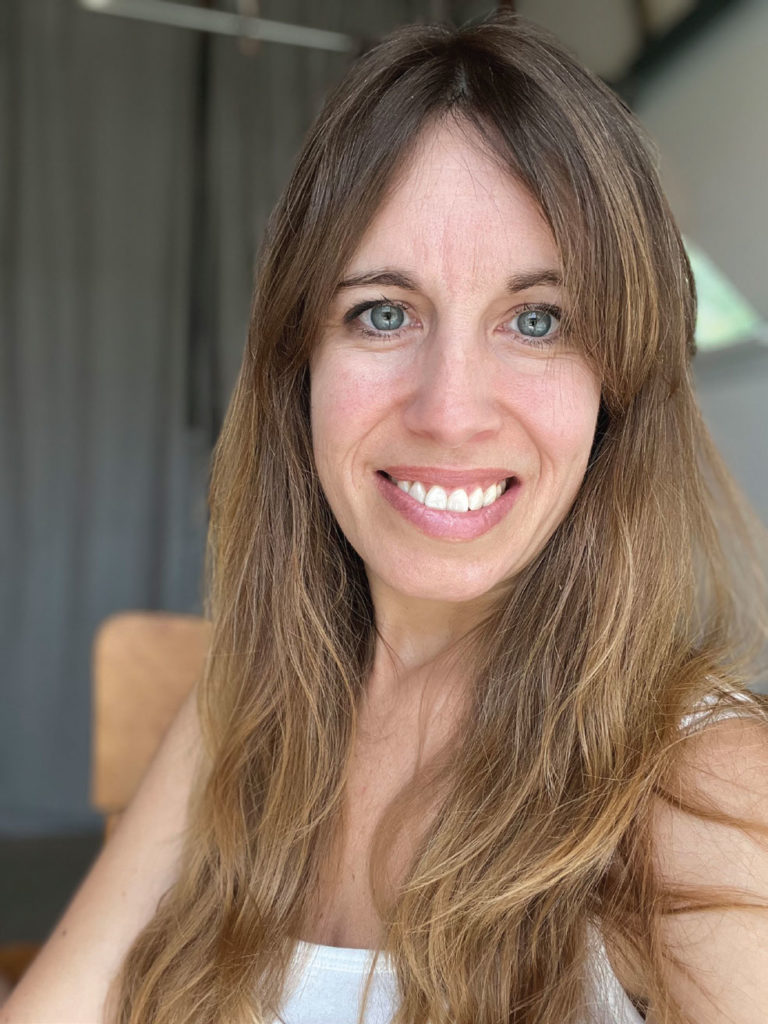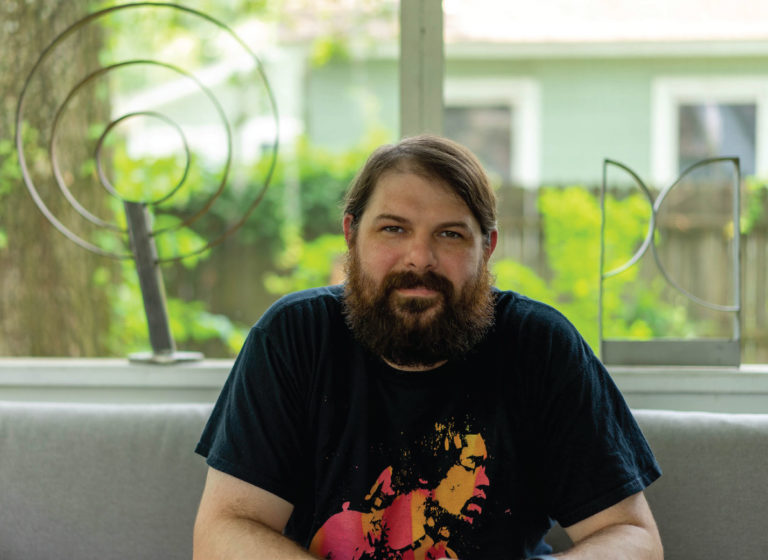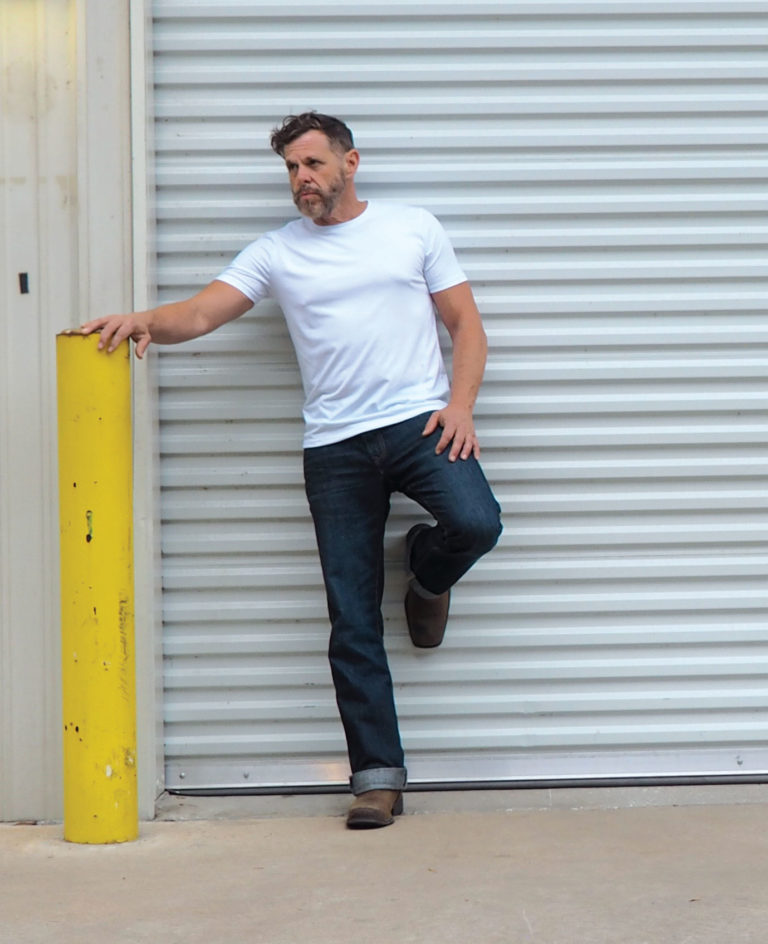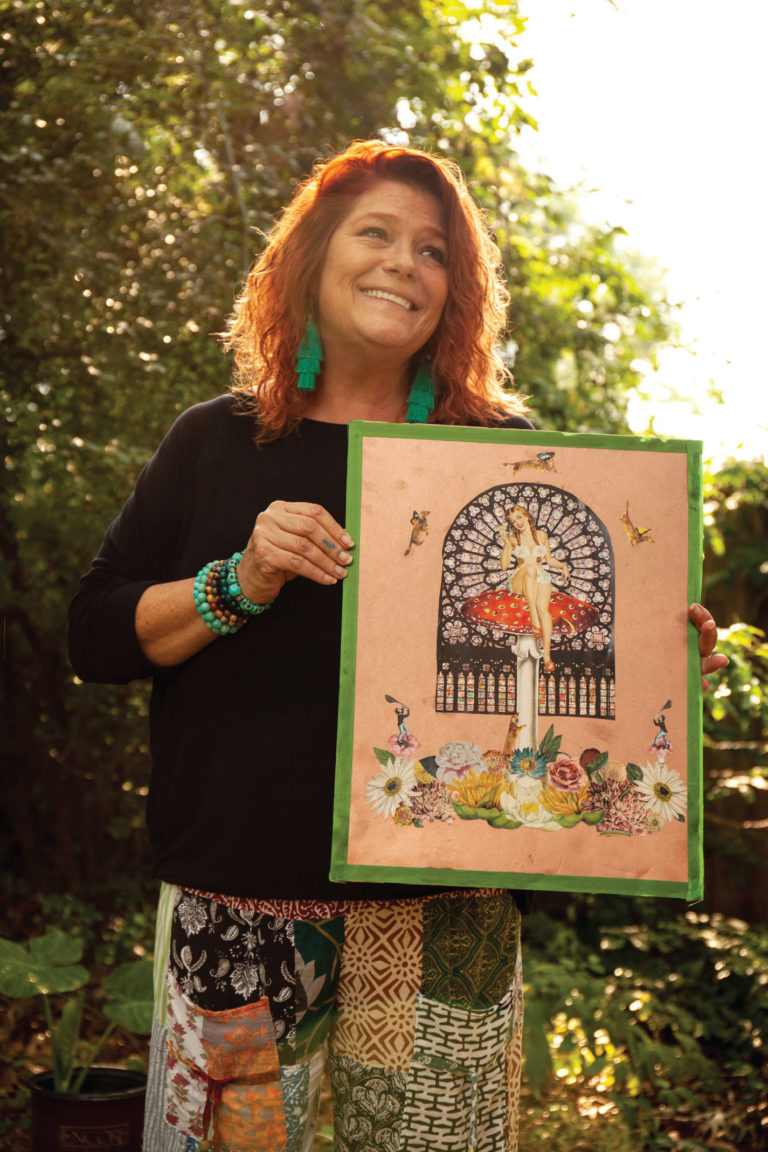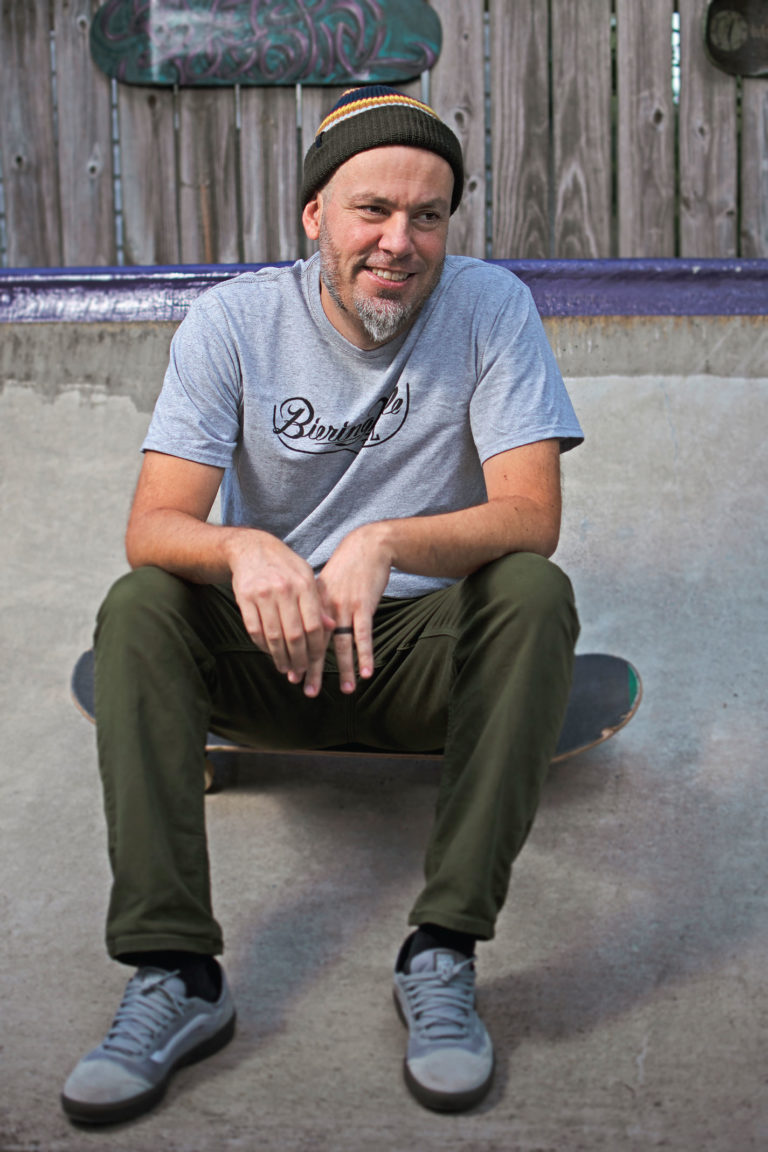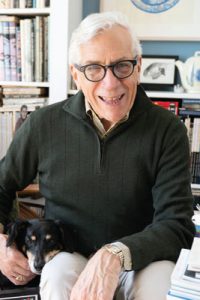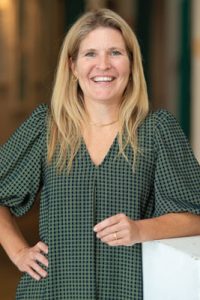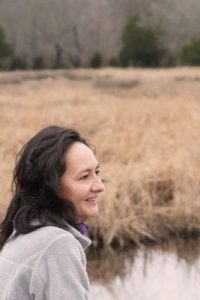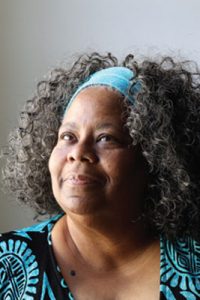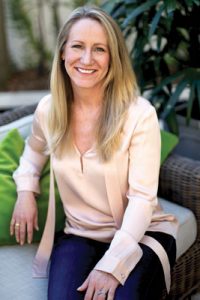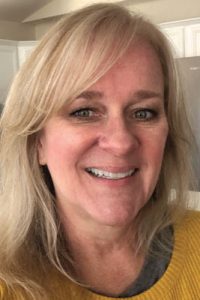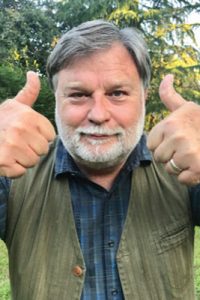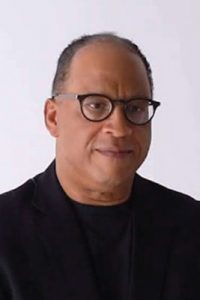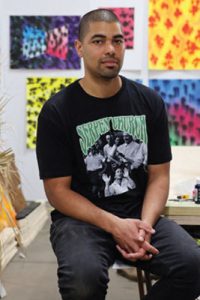Among the 88 local artists who answered our Spring call for submissions, 10 winners were selected by our panel of judges.
Preview their outstanding works, which will be exhibited at Redux Contemporary Art Center, opening with a reception on September 22 and on view through November 4.
The Winners:
As a kid in Williston, South Carolina, Jeremy Croft stood out for his artistic talent. He remembers praise from a third-grade teacher and the high school art instructor who entered his work in a contest. But the idea of making a living creating art didn’t occur to him. “It wasn’t a part of my culture. It wasn’t explained or encouraged as something you could do with your life,” he says. “You had to pick a career that makes money.”
Disabused of that notion in a college drawing class where he was exposed to professional artists, Croft began to test the waters in Charleston, albeit in the shallow end. With two kids under the age of two, he felt he couldn’t quite give up his day job in an office. “I did that for a while, but it started to shift,” he explains. He wanted to show his children that what they wanted to do with their lives was important. “I felt a heavy responsibility to break the cycle.” (Turns out, his kids—three of them now—are artistically inclined as well.)
But it wasn’t until Croft came across a catalog at The George Gallery for a show by local abstract artist Tim Hussey, that he was all in. “I thought really good art was being made somewhere else like LA or New York, but I saw that he was from Charleston and his work was phenomenal,” he recalls. “It made me feel like it was possible.”
In the summer of 2019, Croft quit his job to focus full-time on painting. His first collection was inspired by the apathy of the peak-pandemic era. “All my friends were super opinionated about everything, but no one was doing anything,” he says. “I looked at them and looked at myself and made this series of people dressed as my contemporaries, people of my generation, with their hands in their pockets like, ‘You’re here, but you’re a little complacent.’”
He titled it “Casual Satisfaction” and put it online, where it was well received. “It was satisfying, and it was a really good feeling. Other artists that I looked up to and who are further along in their careers were sharing it on Instagram and saying it was good work, and that was very encouraging,” he says. “Since then, I haven’t stopped painting.”
These days, Croft is making figurative oil paintings that capture ostensibly routine moments—a car interior, a pile of cigarette packs, the back of a trench coat. In his work, he aims to show grandeur in the ordinary. “Everything around us is full of meaning, but sometimes it’s hard to see it,” he says. “This is my way of addressing how prolific our existence actually is, and the fact that we just overlook it most of the time.” —Margaret Loftus
Sean Gallagher began his career as a journalist with a lifelong doodling habit. As an undergrad at Wabash College in Indiana, he created a weekly cartoon called The Slow Life that ran in the school newspaper. To his surprise, it won the All-Collegiate regional award, and he was named “Cartoonist of the Year.” When he went to the University of Southern California for a master’s degree in journalism, he took the comic with him and continued to garner attention and accolades.
Gallagher shelved his illustrations for a few years while he worked as a journalist, including a stint as a city reporter in Hong Kong. When he burned out on writing, he accepted a long-term freelance gig illustrating a workbook for grade-school kids. Then, two years ago, the artist created a comic strip in the style of Edward Gorey, the pen-and-ink artist famous for slightly unsettling narratives in Victorian settings whose funny but dark style aligns with Gallagher’s sense of humor. Two of Gallagher’s Gorey-esque cartoons, versions of The Simpsons and King of the Hill, went viral on social media. Then, his depiction of the cast of Seinfeld posed as the band Weezer on their iconic first album also created a buzz.
After moving to Charleston from Los Angeles in 2017, he continued working as an artist and illustrator, helping companies establish brands, illustrating children’s books, and working part-time designing promotional materials for the Charleston County Public Library. “Most of my work is for myself, though,” he says. “I’m heavily influenced by the 1970s aesthetic and pop culture. I also like still life photography, and I try to recreate that with my art.”
Gallagher says he has had to moderate how dark he gets with his art. For several years, he drew political cartoons to process his angst, some casting his cat, Gimli, as a grumpy villain who wakes up, expresses a wild conspiracy theory, then peacefully goes back to sleep. “I used to love political cartoons, and I did a lot of my own for a while. That’s how I voiced my frustration,” he says. “But it was taking a toll on me. It became my life, and I got tired of snark. It just adds to the angry discourse. Now, I want to entertain and draw snapshots of life. I think people just need a distraction.”
Recently Gallagher helped manage the nonprofit Enough Pie’s mural project, “In Bloom: Awakening Vivian Moultrie Park,” and enjoyed the opportunity to bring more public art to the Holy City. “Coming from LA, I realized Charleston’s been left behind a little bit in terms of what people consider acceptable or artistically pleasing. Hopefully, these ideas grow,” he says.
Today, the artist has an eye on drawing old-school rock posters á la The Criterion Collection. He’s planning to continue illustrating books and submitting cartoons to literary journals and galleries. “This was never my plan, so I can’t fail,” he says. —Robin Howard
Looking at Caroline Herring’s photograph In the Dirt, you may wonder if it’s a photo at all. In it, a pair of poppies sprouting from clumps of dirt appear to be floating through golden air. The blooms (chosen in honor of her grandpa, “Poppy”) droop artfully, and the backdrop—a groovy color plucked straight from one of the petals—feels decidedly nostalgic.
Herring brought the saturated, surrealistic scene to life using floral frogs, real plants, dirt, and a seamless backdrop, then shot it with a digital camera. However, the image itself looks almost digital in nature, as if it’s a product of AI or Photoshop. “The majority of my photographic work relies on the design and construction of a scene,” says Herring. “Without the brief existence of a 3-D set, the photo wouldn’t exist at all.”
After discovering a love of picture taking as a preteen, Herring honed in on both narrative photography and installation art at Clemson University, where she graduated with a BFA in 2018. This spring, she completed a six-week residency at Redux Contemporary Art Center alongside mixed-media artist Nathan McClements. Through the installations she constructed and photographed for their joint collection, “Salvage,” Herring brought fuzzy, distant memories from childhood into crisp, colorful focus. The process flexed her creative muscles (each scene took hours or days to build and shoot) and also helped her mourn the loss of a loved one.
“Upon entering the residency, I was in a weird place of grief,” recalls Herring. “My grandmother had just passed away, and I was coming to terms with the end of my childhood.” In the photographic works, cheery hues cast a ray of utopia on objects, including her grandmother’s pearls and a Southern supper table set with sweet tea and fresh produce. And yet, there’s a hint of melancholy too. In one image, a sign bears the words “Do Not Cross,” a sentiment Herring says she felt at times growing up in Hartsville, South Carolina. “I have some things that I’m still reckoning with, like limitations within the standards that were set for me.”
During her Redux residency with McClements, Herring began experimenting with screen printing. “The nature of what I do with photography is curated and specific, and it takes a long time to get from point A to point B. How Nathan works is so organic—he throws down a piece of cardboard and just starts painting. That free-flowing energy encouraged me to get loose and play like a child again,” she says.
Throughout Herring’s work, including her fine art photography, multimedia prints, and even her commercial photography projects, she underscores the beauty and importance of the objects that surround us. “I’ve always been enamored by the way objects can tell stories,” she says. “I think our things really do define us. It makes me wonder: ‘What are we leaving behind?’” —Molly Ramsey
When Daniel Jacobs was growing up, he spent a great deal of time in the woods surrounding his grandparents’ home in Jamestown, South Carolina. Being in nature made him happier than anything else, so when the house and land were sold after his grandmother’s death, he felt an extraordinary sense of loss.
He found a new connection with nature virtually through the storytelling in video games such as Skyrim—which feature landscapes traditional to the European fantasy genre, such as Lord of the Rings—and Nordic folk soundtracks. Combine the epic settings and moody music, and Jacobs stumbled upon a time machine. “When I found Norse folk music like Wardruna, it was a huge turning point,” he says. “It opened up a whole new world to me and brought back so many memories of nature. I loved it so much that I started researching the history and religion and showcasing it in my artwork.”
Jacobs explains that Norse religion and mythology feature animism, attributing souls to animals and other nonhuman life. Think tree spirits, water sprites, and spirit animals. “I’ve always loved telling and hearing stories,” Jacobs says. “The reason I played video games was to enjoy the story, and the ones I played had to do with nature. Later, I just wanted to tell my own stories through my work. I’m retelling my life but with a Norse saga twist.”
Jacobs, whose mother and other grandmother are also artists, knew in high school that he wanted to pursue an art career. “I decided, ‘This is everything to me. I want to make this my life’s work’,” he says. Today, he’s a senior at the College of Charleston majoring in studio art. His work focuses on pen-and-ink drawings or etchings of Norse sagas and other ancient folklore.
In The Fate of Baldr, Son of Ódin and Frigg, the chief god Ódin’s son lies mortally wounded by a sprig of mistletoe (the only thing that could hurt him) hurled by the blind god Höd. Much like the restless, intricate works of Dutch painter Hieronymus Bosch, there are many more layers of action in Jacobs’s retelling than in the original narrative. Below the dying god, nature seems to be mourning; wolves howl, elk and boar stand at attention, and a crow cries from a pine tree. There’s nearly infinite symbology in Jacobs’s complex works, and none of it is incidental.
Jacobs sees the influence of his early years spent among the trees, Nordic music, and mythology on his life, and his art. “These stories say that no matter who you are, time will not stop you. No matter how good or bad things are, they will inevitably change,” he says. “It means a lot to me to think about fate and how some things you can’t change no matter how much you wish they could.” —Robin Howard
As a College of Charleston undergrad, Kim Thomas noticed how much plastic washed up or was left on the beach. It bothered her then, and it bothers her now. “We’re finding microplastics throughout the world, even in places humans don’t live. As I parent, I wonder what kind of planet we’re leaving our kids,” she says.
That deep-rooted concern for the environment led to her first sculptural experiments during her master of fine arts work at Memphis College of Art. Though she’d dabbled in different mediums, Thomas eventually decided to focus her art on environmental issues, specifically plastic. “Plastic is both problematic and cheap or free, so plastic bags became my main material,” she says.
For her first project in 2010, she raided her friends’ stashes of bags kept under sinks or in pantries and garages. Then she cut the bags into strips, looped them together, and started crocheting. “I learned to crochet when I was eight, but easily picked it back up again and just started making these crazy organic forms.”
Thomas’s large abstract and biomorphic sculptures and wall hangings demand viewers to confront their relationship with plastics. “When I made the first pieces, the feedback I got was, ‘This is a big issue, you need to work bigger.’ So I did.” One of her largest pieces to date, Mass 2, measures nearly nine feet tall and more than five feet wide.
While most of the plastic Thomas uses is in earthy blacks, browns, and whites, the random strands of industrial red, blue, and yellow remind the viewer that this is anything but an organic work of art. Though the strands are crocheted, they feel tangled and fused by time and tide. “I am particularly interested in the way the forms mimic our consumption and our relationship to pollution, which spreads over and suffocates the world around us, just as plastics become entangled in the environment,” she says.
In the spirit of calling people in instead of calling them out, Thomas keeps her work purposefully abstract, so it’s still open to interpretation. “It’s nice to look at, but you can’t deny the material used,” she explains.
Today, the art teacher at Cane Bay High School incorporates different kinds of plastic, from bags to bubble wrap, packaging, and mailers. After she gathers her mountain of materials, she flattens everything out, folds it, cuts it, then loops it into a single strand to create something like a big ball of yarn. The process is laborious; creating a soccer-ball-sized sphere of plastic takes at least 14 hours. However, Thomas finds working with a material that has caused her so much frustration helps lessen her anxiety. “In the end,” she says, “I want people to see that the world we live in is really complex and beautiful and so worth protecting.” —Robin Howard
“I didn’t have any desire or inkling to be an artist,” admits Jonathan Varnell, a Columbia, South Carolina, native who moved to Charleston in 2015. After buying a camera for the first time at age 32, a hobbyist interest eventually turned into a pursuit of a formal art education at Trident Technical College.
Varnell’s photography feed on Instagram reveals a grid of minimalistic, black-and-white images that boldly play with light and shadow, geometric shapes, and repeating patterns, finding beauty in overlapping shingles, brick facades, wooden banisters, and intricate cracks in the pavement. “I took portrait classes but didn’t enjoy it as much as taking pictures of random lines,” he says.
Encouraged by his professors at Trident, Varnell began taking art classes at College of Charleston, where he gained an interest in sculpture. Taking inspiration from the minimalist aesthetic of his photography, he began creating his 2021 “Discarded” series, using materials such as nails, screws, and wood scraps leftover from fellow students’ projects.
The simplistic but engaging wall hangings take on familiar shapes, some resembling a snaking labyrinth or a piercing eye, but Varnell encourages viewers to assign their own meanings. “One theme in the background is the correlation between the natural elements and man-made materials such as wood and nails,” he says. “What did these things used to be? Each of these works are made with pieces intended for completely different purposes, and now it’s art.”
Varnell puts an emphasis on integrating found materials and letting spur-of-the-moment inspirations guide the process, both in his 3-D works and in his latest creative endeavor, experimenting with lensless photography. “It’s very intuitive,” he says. “I don’t go into it thinking, ‘Tomorrow, I’m making something with squares.’ A lot of times, I’ll be driving and pull a quick U-turn because something looks cool in a pile of wood someone’s tossing out.”
Varnell, who lives in West Ashley with his wife and two dogs, is pursuing a master’s degree in business administration at The Citadel. His work has been featured in the Young Contemporaries exhibition at the Halsey Institute of Contemporary Art in 2020 and 2021, winning the best sculpture award in 2020.
Despite the accolades, Varnell’s greatest wish is to let his work speak for itself. “I’ve spent a lot of time trying to take ego out of my art, because I don’t want to be in control of what the art makes you feel,” he says. “I’m just letting these ideas flow into things.” —Holly Roberts
As an art director who came up in the advertising world of the 1990s, the artist working under the name Bruise Wayne has a resume stacked with some of Madison Avenue’s most venerable agencies, including Young & Rubicam and Wunderman. He even spent a few years working with ad giant George Lois—often called one of the original “Mad Men” of the 1960s—a mentor who taught him much about evoking emotion through art.
Those were heady times for a young creative in New York. “It was wild and amazing. As an art director, you’d get tons of respect. It really was super, super fun,” Wayne says. But all that soon changed with the advent of data-driven marketing. “Advertising’s different now,” he continues. “You just have to get the right message to the right person at the right time.”
Feeling less fulfilled in his work and pressured by its breakneck pace, Wayne began to reassess his career. “I looked at it like, ‘I have these God-given talents and I’m using it to sell…insurance?’ It really started to nag my soul.” In 2019, he and his wife decided to move their four children from Long Island to Charleston, where he had more time to reflect, not just on his personal trajectory, but on the state of our culture. Mostly, he worried about the momentum of digital technology and its impact. “We’re high-speed innovating and not stopping to think about what it is doing to us and our society, but we’re still flying at 800,000 miles an hour toward we don’t know what.”
As a creative, Wayne felt compelled to bring attention to what he views as a crisis. “Nobody is keeping anybody honest. It’s on the artist, it’s on us,” he argues. “I started to feel like if I sit on the sidelines and don’t say anything, then I’ll be the witness to a crime.”
Drawing on his art school training and decades of advertising experience engaging an audience, Wayne began to build dimensional works intended to illuminate our—and our children’s—relationship with technology. The result is his first art collection. In one of his pieces, he refashioned the familiar Google search screen on a gutted desktop computer to read “God,” suggesting that the tech giant who promised not to be evil has strayed from its mantra. “With a massive collection of data on its users and a practical monopoly on ‘instant knowledge,’ is it any wonder this tech powerhouse has become a bit drunk with power? How could anyone maintain integrity with so much influence over its users?”
Wayne says the collection is meant to unite people around ideas that we can agree on, such as kids connecting through real play and using tech as a tool. “How can we bring balance back to our lives? How can we use these powerful tools instead of them using us?” he asks. “Ultimately, I challenge us all to look long and hard before we leap into the technological abyss.” —Margaret Loftus
“I’m a shadow hunter,” says Jalen Williams. Armed with a Mamiya SLR film camera, a Sony digital camera, a tripod, a stabilizer, and a stepladder, the photographer uses darkness and light to draw viewers’ focus to the more poignant elements of his staged scenes. That dichotomy holds more than just visual interest for the 22-year-old North Charleston native, who often tucked into the shadows as a boy. “I’ve always felt like an outsider,” he says.
Homeschooled until third grade, Williams says he was a solitary kid who wanted to be a filmmaker. He picked up his first point-and-shoot camera at 15 to practice composition and recording. His photographs often exude loneliness, like the moody It Used to Be Warm, Williams’s somber nod to the passage of childhood.
Even into college, he had the sense of being stuck on the fringes. At Coker University in Hartsville, South Carolina, he hesitated to declare an art major and then struggled through prerequisite drawing and 3-D design classes before feeling things click during his photography courses. A class prompt about identity led to the creation of Invisible Man, a nod to the Ralph Ellison novel, illustrating the situational personalities Williams feels he must adopt. “I’m still searching for that sense of belonging, but as I get older and understand myself more, I’ve become more confident about the search,” he explains.
That pursuit inspired his senior thesis, “Where I’m Coming From,” which recently culminated in a show at the Cecelia Bell Coker Gallery. In the series, “Blood Will Tell,” the artist surveys the former cotton field at the Coker Pedigreed Seed Company, searching for a future among the trees and then falling to his knees in prayer in a patch of nearby sunlight. And the triptych He Ain’t Heavy showcases two men, clad in the conventional tank undershirts of the artist’s youth, regarding each other with both tenderness and violence, his vision of masculinity.
Williams’s photographs often appear in groups of two or three, the product of his wish to one day work in film. “As much as I love the impact of a single image, a series creates a narrative,” he notes.
Of course, when a particular scene implants itself in Williams’s mind, sometimes all that’s needed to tell the story is a meticulously constructed tableau. He admits that he’s still unsure about the meaning behind the striking portrait of a scrawny person dressed in an antebellum hoop skirt and wielding a revolver, but he felt moved to compose the scene after a strange, lingering dream. Though he initially worried how the image would be perceived, Williams’s mother encouraged him to share the photograph. Scorned appeared in the 2023 Piccolo Spoleto Juried Art Exhibition. As recognition of this reserved photographer’s talent grows, he’s finally stepping out of the shadows and into the light. —Lauren B. Johnson
A decision to organize a messy hall closet led local bookseller and mother of three Carrie Wooden to discover a way to de-stress during the pandemic, as well as a creative outlet. When Wooden was hesitant to part with shelves full of vintage magazines and children’s books, her kids introduced her to the Instagram account of a Spanish collage artist. Inspired, she began creating simple collages of her own using recycled and repurposed items, often representing humorous and unexpected relationships between animals and humans.
“Saving these fabulous books and magazines from ending up in the landfill is the ultimate in sustainability, not just for the pictures but also the history these images contain,” says Wooden, who regularly scours estate sales and secondhand stores for materials such as wallpaper, maps, posters, and more. “We are such consumers, but everything we have we can reuse.”
In 2020, when Redux Contemporary Art Center opened submissions for its 18th-annual art auction with the theme of being stuck at home during quarantine, Wooden submitted her second-ever collage, My Blue Oasis, which was accepted and displayed in the gallery. The piece depicts a woman wearing bunny ears, taken from a vintage circus book, smiling at viewers from inside a fishbowl.
While earlier collages used as few as three pieces and solid card-stock backgrounds, newer works can layer more than 50 different elements, remaining unfinished for months until the perfect final touch is found. For Let’s Start a Howl, Wooden began with a romantic wrapping paper intended for wedding gifts, eventually adding a pair of wolves and the embracing bodies from Alfred Eisenstaedt’s iconic photograph, V-J Day in Times Square, clipped from a Life magazine book.
“They’ve improved from me having one pair of scissors at the dining room table and losing pieces because somebody would open the damn back door,” laughs Wooden, whose home studio is filled with endless bowlfuls and stacks of scrap paper. “Sometimes, I’ll have a collage assembled but will struggle with a background, and that can put me back a couple weeks. But I’ll revisit it until something clicks.”
Wooden, who has called Charleston home since 2000, lives with her wife, children, and two dogs on James Island. While still working at Barnes & Noble a few days a week, she sells her collages online via Etsy as CollageKitsch, locally at Cornercopia and the James Island Cultural Arts Center, and during market events such as Celadon’s Flea-esta, Feminist Magic Market, Pickers Hullabaloo, and Thrifters and Drifters. With no formal art background, she credits a twist of fate to her newfound success, hoping to turn collaging into a full-time job by early 2024.
“I’m a true believer in serendipity,” says Wooden. “It took me into my 40s to realize there’s a meaning for everything, even organizing that hall closet. Everything is a puzzle, you just have to make it fit.” —Holly Roberts
Karl Zurflüh was just 11 months old when his father, a Navy pilot, was killed in action. Now 49, the artist revisits the loss in “Light Pilots,” a series of canvases and panels in charcoal, acrylic, aerosol, and latex depicting a fighter pilot floating in space. With each of the 22 pieces, Zurflüh examines his subject from a new vantage point, like so many facets of loss. “I hope this series can help others learn to deal with or at least talk about their grief as they go through this journey with me,” he says.
But these aren’t dark paintings; rather, light is the focal point of each. “Light represents hope and growth,” Zurflüh explains in his artist statement. “In all cases, the light becomes the positive pulling force. It is up to you to choose what to do with it.”
Just as the works represent a lifetime of emotional healing, the skills and techniques used in making them are a culmination of Zurflüh’s wide-ranging talent and experiences in art. As a youngster growing up in Tacoma, Washington, he lost himself in comic books, video games, and drawing. He had every intention of becoming a pilot like his father (and grandfather), but getting his wings lost its luster by the time he was a junior in high school. For Zurflüh, the art world was calling.
After high school, he studied fine art at Cornish College in Seattle, where public buses were his main mode of transportation, giving him a front-row seat to the city’s graffiti. He was galvanized by it all. “I dove in head first,” he recalls. After a couple years, he started getting commissions and has been painting murals ever since (including 13 of them in Charleston). “I love the impact that murals make,” he says. “When you walk around a corner and you’re suddenly hit with vibrations of color, it’s that ‘wow’ moment that inspires me.”
A chance meeting at a gallery with Joe Barbera, cofounder of the animation studio and production company Hanna-Barbera, encouraged Zurflüh to refocus his studies on animation. He transferred to Ringling College of Art and Design in Sarasota, Florida, to major in illustration and later earned a master’s in computer animation at the School of Visual Arts in New York. But it took a job at Nickelodeon for him to realize animation wasn’t where he belonged.
After a stint designing movie posters, Zurflüh found a professional home in video game advertising at a Los Angeles agency, whose clients include Activision (as in Call of Duty). Fast-forward 10 years, and he felt the pull of the Lowcountry, home of his wife’s family. Zurflüh now works remotely for the agency, and his life is far less demanding, giving him time to build a career as an independent artist.
For now, his goal is to create more paintings in the “Light Pilots” series, aiming for a total of 30 or 35 for a show next year. After that, he’s got some more ideas that he’s been sketching out, but hasn’t landed on anything yet. Who knows, he says, more “Light Pilots” may be in the offing. “It’s a healing thing for me.” —Margaret Loftus
Judges & Exhibit
Meet our panel, who reviewed and scored all submitted work online and selected our 10 winners
“Contemporary Charleston 2023: Under the Radar”
September 22 - November 4
Redux Contemporary Art Center, 1056 King St.
Opening Reception: Friday, September 22, 5-8 p.m.
See works from the winners at the exhibition and meet the artists at the opening reception. All artwork will be available for sale, with 20 percent of the proceeds benefiting Redux, a nonpro t committed to fostering creativity and the cultivation of contemporary art through diverse exhibitions, affordable studio space for visual artists, and education and outreach programs for the community. For more information, call (843) 722-0697.
Special Evenings “Under the Radar”
During the run of the exhibition, Charleston Arts Festival will be presenting these musical performances amid the artwork.
September 28:
Experience Duo with Zandrina Dunning and Stephen Washington; Thursday, 7:30 p.m. Tickets: $30, $25 advance at charlestonartsfestival.com
October 8:
New Muse Concerts’ “Felices Dias: Happy Days,” featuring works by the Maharajah Flamenco Trio; Sunday, 5 p.m. Tickets: $35 at newmuse.org
October 21:
Grace McNally featuring Gino Castillo “Full Circle” in concert; Saturday, 7:30 p.m. Tickets: $30 at charlestonartsfestival.com
Under the Radar Print Feature:

CHARLESTON MAGAZINE
FOOD & DRINK
ARTS & EVENTS
- EVENTS CALENDAR
- ARTIST PROFILES
- MUSIC
- BOOKS
- EDITORS’ PICKS
- PARTY SCENE
STYLE & SHOPPING
- TRENDS
- STYLE Q & A
- FASHION
- STYLE BUZZ
- LOVE IT!
